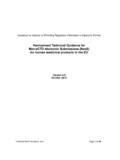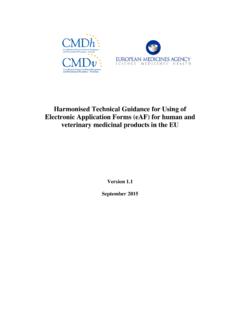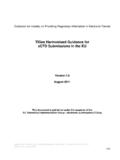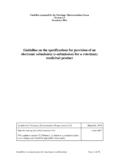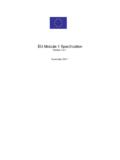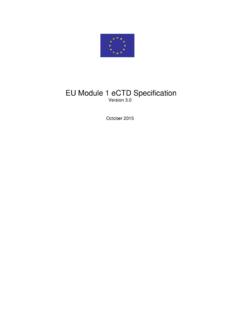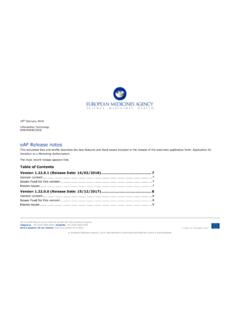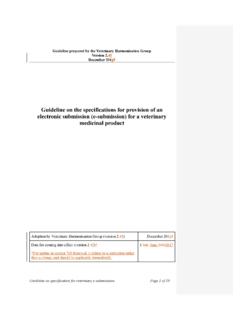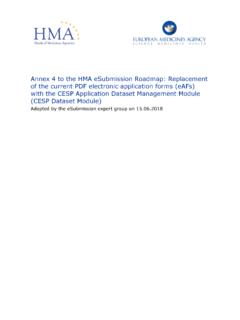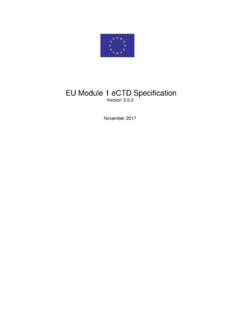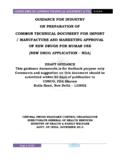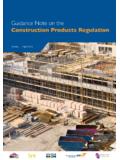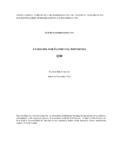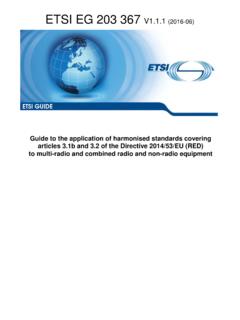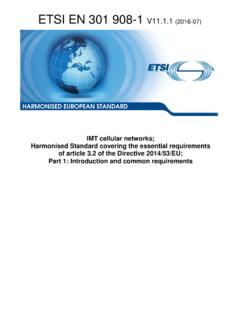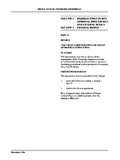Transcription of eCTD Guidance Document - Europa
1 Page 1 of 60 Guidance for Industry on Providing Regulatory Information in Electronic Format harmonised technical Guidance for ectd Submissions in the EU Version August 2013 technical ectd Guidance Page 2 of 60 Table of Contents Table of Contents .. 2 List of Tables .. 4 List of Figures .. 4 1. INTRODUCTION .. 5 Glossary .. 6 2. GENERAL CONSIDERATIONS .. 7 Scope .. 7 Structure of Submissions .. 7 Transitional 8 Moving to ectd Format from Paper or NeeS Type Applications .. 8 General Submission Considerations .. 9 Correspondence .. 9 Paper 10 Hardware .. 10 General technical ectd Information .. 10 Other technical Information .. 16 Number of Media Requested .. 18 technical Baseline Applications .. 19 3. MODULE SPECIFIC INFORMATION .. 23 General Information .. 23 Module 1 ectd Envelope, Administrative Information and Prescribing Information Folder 23 Module 2 Overviews and Summaries Folder.
2 26 Module 3 Quality Folder .. 26 Module 4 Nonclinical Study Reports Folder .. 27 Module 5 Clinical Study Reports Folder .. 27 4. ADVICE ON SPECIFIC APPLICATION TYPES .. 29 Initial MA Applications .. 29 Variation Applications .. 30 Extension Submissions .. 31 Renewal Submissions .. 32 PSURs .. 33 Referrals .. 33 Active Substance Master Files .. 34 Vaccine Antigen Master Files .. 34 Plasma Master Files .. 34 Applicant Initiated Withdrawals .. 34 Applicant Withdrawal or Agency Rejections of Regulatory Activities .. 35 Duplicate Applications .. 35 ANNEX 1: ectd REFERENCE DOCUMENTS .. 36 ANNEX 2: Guidance ON TEXT SEARCHABLE DOCUMENTS .. 37 A2-1 General .. 37 A2-2 Documents that Must Always Be Text Searchable .. 37 A2-3 Documents that Do Not Need to Be Text Searchable .. 38 A2-4. Further Information .. 38 ANNEX 3: Guidance AND BEST PRACTICE ON THE STRUCTURE OF MODULE 3 .. 39 A3-1. Introduction .. 39 A3-2 General Principles.
3 39 technical ectd Guidance Page 3 of 60 A3-3 Module 3 XML Attributes in the ectd .. 42 ANNEX 4 MANAGEMENT OF PARALLEL VARIATIONS IN THE ectd .. 52 A4-1. Background .. 52 A4-2. Business Challenge .. 52 A4-3. Best Practice .. 52 A4-4. Description of Figures .. 53 technical ectd Guidance Page 4 of 60 List of Tables Table 1: Example of an initial MAA in the Centralised 11 Table 2: Example of an initial MAA in the Decentralised Procedure .. 12 Table 3: Example of a Variation .. 12 Table 4: Example for starting an ectd with a baseline sequence .. 19 Table 5: Example for starting an ectd with regulatory activity sequence .. 19 Table 6: Initial MAA Centralised Procedure .. 29 Table 7: Centralised Procedure - Outside ectd via 29 Table 8: Initial MAA Decentralised Procedure .. 30 Table 9: Type II Variations Centralised Procedure .. 30 Table 10: Type IA & IB Variations Centralised Procedure .. 31 Table 11: Centralised Procedure, Outside ectd via EudraLink.
4 31 Table 12: Renewal Centralised Procedure .. 32 Table 13: Centralised Procedure Outside ectd via EudraLink .. 33 Table 14 (A3): Advantages and disadvantages of ectd application 41 List of Figures Figure 1: Sample of folder structure .. 15 Figure 2 (A3) Illustration of what an ectd covers for a product with the invented name Wonderdrug , Centralised Procedure .. 40 Figure 3 (A3) Single Drug Substance, 2 Manufacturers with similar documentation, the few site/manufacturer-specific documents are identified by the XML title (not by adding an additional XML section): .. 44 Figure 4 (A3) Single Drug Substance, 2 Manufacturers with significant volume of different documentation (one section for Acme Chemicals, another for Pharmasupply) .. 46 Figure 5 (A3) Approach 1 One 32p for all Strengths, any strength specific documents identified by the XML title, not by adding an additional XML section .. 48 Figure 6 (A3) Approach 2 - Separate XML elements and documents for Strengths significant content differences, but Pharmaceutical Development only provided once in the folder structure and referred to from the XML twice.
5 50 Figure 7 (A4): Description of elements .. 53 Figure 8 (A4): Use of one Document lifecycle .. 53 Figure 9 (A4): Use of separate Document lifecycles with different title attributes .. 55 Figure 10 (A4): Replacement of approved content by newly approved content, and deletion of proposed content .. 55 Figure 11 (A4): Progression on the 2nd Parallel Proposal .. 57 Figure 12 (A4): Replacement of approved content by newly approved content, and deletion of multiple proposed documents .. 58 technical ectd Guidance Page 5 of 60 1. INTRODUCTION This Guidance Document is intended to assist pharmaceutical companies with the submission of regulatory information in electronic Common technical Document format ( ectd ) to the National Competent Authorities (hereafter referred to as NCAs) and the European Medicines Agency (hereafter referred to as EMA). The ectd format is regarded as the principal electronic submission format in EU for human medicinal products and is the only electronic format that is accepted by the EMA.
6 However, the Non ectd electronic Submissions (NeeS) format is also accepted by most NCAs and therefore a Guidance Document for NeeS has been published on the EMA eSubmission website as well. The Guidance has been created by the TIGes Harmonisation Group, a sub-group of the Telematics Implementation Group for electronic submissions (TIGes), and has been adopted for publication by the TIGes. It should be stressed that this Guidance reflects the current situation and will be regularly updated in the light of changes in national and/or European legislation together with further experience gained within NCAs of using information submitted in electronic format. If needed, there are also Q&As published in between versions of this Guidance as a response on change requests or new requirements to be addressed (see EMA eSubmission website) This Document consists of four parts: Introduction, General Considerations, Module Specific Information and Advice on Specific Application Types together with associated annexes.
7 technical ectd Guidance Page 6 of 60 Glossary A brief glossary of terms (for the purpose of this Document only) is indicated below: Term Definition Applicant A pharmaceutical company or its agent that is submitting information in support of an application. Applicant s information Regulatory information submitted by an applicant for, or to maintain, a marketing authorisation that falls within the scope of this Guidance Document . ectd application A collection of electronic documents compiled by a pharmaceutical company or its agent in compliance with European legislation and guidelines in order to seek a marketing authorisation or any amendments thereof. An ectd application may comprise a number of sequences. In the EU an ectd application may comprise several dosage forms and strengths, all under one invented product name. Some review tools describe such a collection as a dossier.
8 Procedure A Community registration procedure for the authorisation of medicinal products in the European Community. There are 4 types of procedure that operate within the EC Centralised, Decentralised, Mutual Recognition and National. Submission or Sequence A single set of information and/or electronic documents supplied at one particular time by the applicant as a part of, or the complete, ectd Application. In the context of ectd , this is equivalent to a sequence. Regulatory activity A collection of sequences covering the start to the end of a specific business process, an initial MA application or Type II variation. It is a concept used in some review tools to group together several business related sequences. technical ectd Guidance Page 7 of 60 2. GENERAL CONSIDERATIONS Scope Types of Product This Guidance covers the submission of electronic regulatory information for all human medicinal products falling within the competence of NCAs in the EEA as well as the EMA.
9 This includes prescription, over the counter medicines, innovative and generic product submissions. The product types include small molecules, biotech products, herbals, vaccines, homeopathics and blood products. Types of Submission This Guidance applies to all submissions related to the authorisation and maintenance of medicinal products, including new marketing authorisations, variations, renewals, PSURs, active substance master files (ASMF), Plasma Master Files (PMF) and withdrawals. For variations, ASMF and PMF there are also specific Guidance documents (see references in Part 4). Types of Procedures This Guidance covers applications made in any of the applicable Community procedures (National, Mutual Recognition, Decentralised and Centralised). For submissions within MRP and DCP, please refer to the specific CMDh Guidance Requirements on submissions for New Applications within MRP, DCP or National procedures Exceptions This Guidance does not apply to the electronic submission of pre-marketing authorisation (MA) information such as scientific advice, clinical trial applications, Orphan drug designations, PIP submissions and related submission correspondence as well as dossier content explicitly excluded from the commonly maintained electronic dossier.
10 (Please refer to the CMDh website on eSubmission for the BPG and Q&As for further exceptions.) Structure of Submissions This Document provides Guidance on how to organise application information for electronic submission using the ectd specifications. Guidance on the detailed information to be included is described in the Common technical Document (CTD), and relevant ICH and EU Q&A documents. The structure and organisation of an ectd submission is defined by the following standards: ICH M2 ectd Specification EU Module 1 Specification Relevant ICH and EU Q&A docs Annex 1 contains links to the currently approved version of these documents. Typically, an ectd application will cover all dosage forms and strengths of a product. In the centralised procedure, this will be equivalent to all dosage forms and strengths covered by an EMA application number ( EMEA/H/C/000123).
